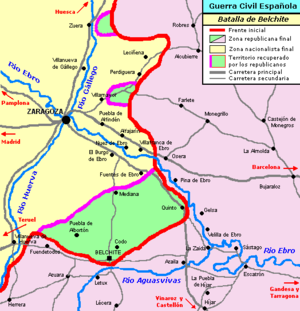Battle of Belchite
| date | August 24 to September 7, 1937 |
|---|---|
| place | Near Belchite , Spain |
| output | Republican victory |
| consequences | Destruction of the city of Belchite |
| Parties to the conflict | |
|---|---|
| Commander | |
|
Alfonso Trallero † |
|
| Troop strength | |
| 80,000 infantrymen 105 tanks 90 planes |
approx. 50,000-100,000 infantrymen |
| losses | |
|
unknown |
unknown |
Spanish Civil War (1936-1939)
Gijón - Oviedo - Alcázar of Toledo - Mérida - Badajoz - Guipúzcoa - Mallorca - Sierra Guadalupe - Talavera de la Reina - Madrid - Road to Coruña - Málaga - Jarama - Guadalajara - War in the north ( Durango , Guernica , Santander ) - Brunete - Belchite - Teruel - Cabo de Palos - Aragon - Ebro - Catalonia

The Battle of Belchite took place during the Spanish Civil War between August 24 and September 7, 1937 near and in the city of Belchite , which was almost completely destroyed in the process.
prehistory
After the Battle of Brunete and the failed attempt by the Republicans to cut off the nationalist front arch in front of Madrid , the Republican General Staff decided on a series of smaller offensives in Aragon to stop the advance of the nationalists in the north. It wasn't just purely military reasons that led to this decision. The central republican government saw this as an opportunity to reduce the influence of the CNT - FAI and the POUM in the region. For this purpose, communist troops and the three anarchist divisions were combined in the newly established Army of the North under the command of General Sebastián Pozas .
Another aim of the offensive was the capture of the provincial capital of Saragossa , which was only a few kilometers behind the front. The capture of the city would not only have been a symbolic act, but the city was also the communication center of the nationalist positions in the region. The first year of the Civil War had shown that controlling cities was far more important than occupying large swathes of land. The nationalists had only three divisions (51st, 52nd and 105th divisions) at their disposal, which were also distributed on a front line of 300 km in length and concentrated in the cities.
General Pozas and his chief of staff, Antonio Cordón, set up their headquarters in Bujaraloz . The plan envisaged breaking through the nationalist positions at eight different points on a front length of 100 km between Zuera and Belchite . The reason for the division of the attacking troops was that it was assumed that this tactic would also split up the nationalist forces and thus deprive them of the possibility of counter-attacks. Furthermore, the smaller Republican units offered worse targets for the air strikes than at Brunete.
Republican offensive
The Republican Army of the East and the XI. and XV. international brigades began the offensive with 80,000 soldiers, three aircraft squadrons from a total of 90 Polikarpow I-15 ( Chatos ) and I-16 ( Moscas ) and 105 T-26 tanks. The attack was staggered in three main and five secondary thrust directions over a width of 100 km. In the north and in the center, the Republicans could only achieve small gains. In the southern sector of the front they succeeded in conquering the villages of Mediana and Quinto . Three Carlist companies were entrenched in the village of Codo and held up two whole Republican brigades. The resistance was most intense in Belchite , where 7,000 defenders defended the encircled city until September 7th. With the use of cannons, dynamite and bayonets, every house and every meter were fought. Prisoners were not taken. On September 6, 1937, Belchite was completely destroyed. This delay gave Franco time to bring in reinforcements and thus prevent the Republicans from advancing into Zaragoza.
Nationalist counter-offensive
The nationalists began their counteroffensive on August 30th with five divisions, two of which had to be withdrawn from the front near Madrid , artillery and 65 Fiat CR.32 , Heinkel He 46 , Savoia-Marchetti SM.79 and Messerschmitt Bf 109 fighter planes. The counterattack was called off on September 6th because it was not possible to break through the Republican positions.
consequences
Although the Republican side managed to gain up to 10 km of terrain, the offensive was a failure. The nationalists did not postpone their offensive in the north, as they had to do before the Battle of Brunete , and Zaragoza could not be captured.
The entire city of Belchite was completely destroyed during the fighting. Franco ordered that the ruins should be left untouched as a monument to war. A new city was built for residents nearby.
literature
- Antony Beevor : The Battle for Spain. The Spanish Civil War 1936-1939. Weidenfeld & Nicolson, London 2006, ISBN 0-297-84832-1 .
- Walther L. Bernecker , Sören Brinkmann: Battle of the memories. The Spanish Civil War in Politics and Society 1936–2006. Verlag Graswurzelrevolution, Nettersheim 2006, ISBN 3-939045-02-0 .
- Isaías Lafuente: Esclavos por la patria. La explotación de los presos bajo el franquismo. Temas de Hoy, Madrid 2002, ISBN 84-8460-183-8 .
- Javier Rodrigo: Cautivos. Campos de concentración en la España franquista, 1936–1947. Editorial Crítica, Barcelona 2005, ISBN 84-8432-632-2 .
- Hugh Thomas : The Spanish Civil War. Revised and updated edition. Modern Library, New York NY 2001, ISBN 0-375-75515-2 .
Web links
- Ralph Hug: A ruin for Franco's God and Fatherland. In: The weekly newspaper. WOZ. No. 28, July 13, 2006.

